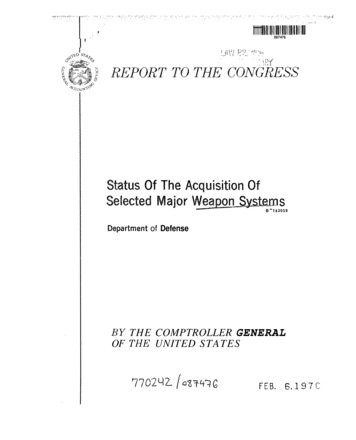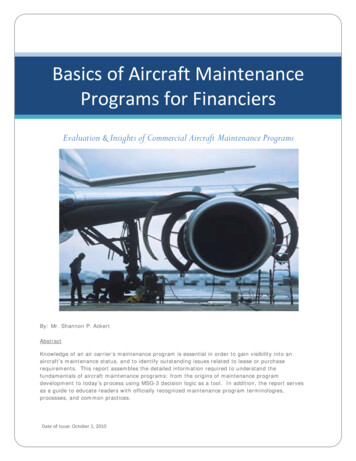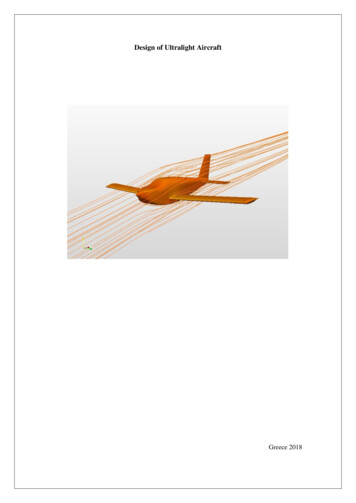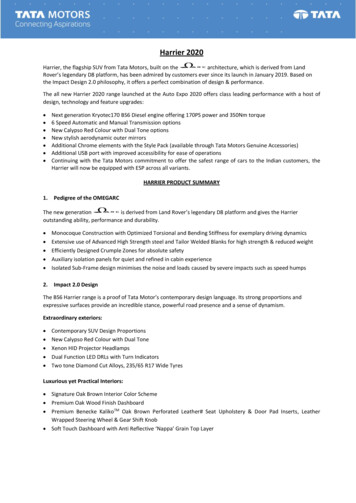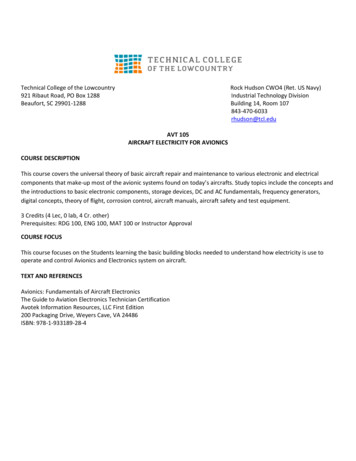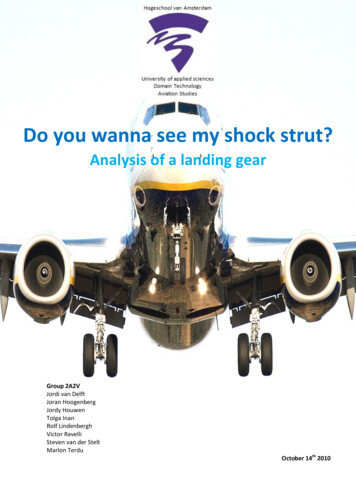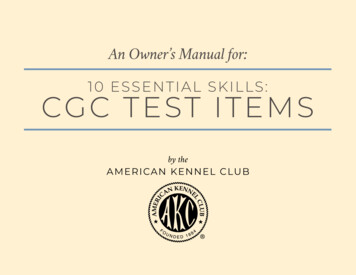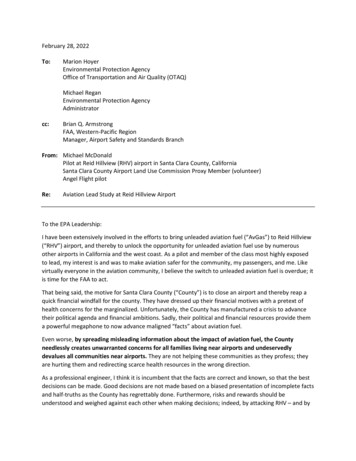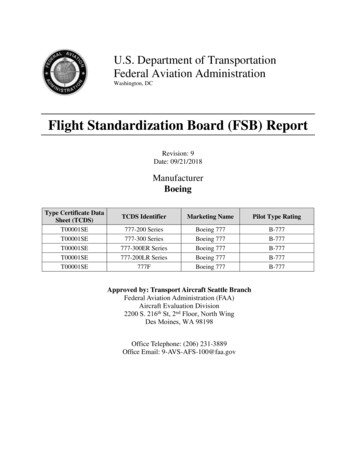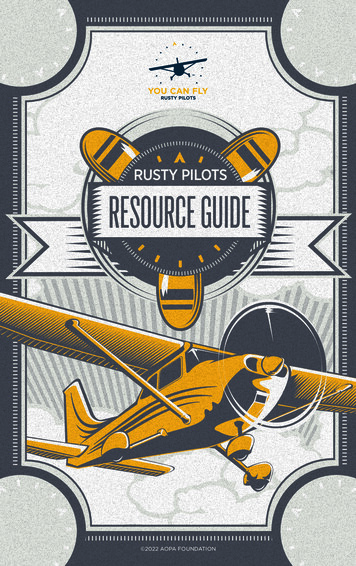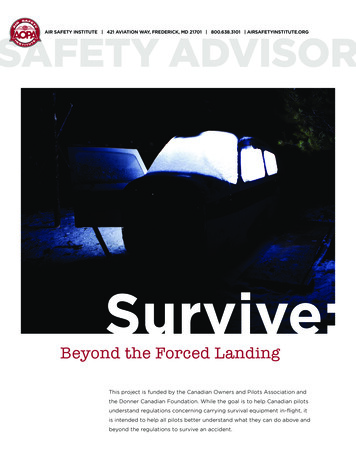
Transcription
AIR SAFETY INSTITUTE 421 AVIATION WAY, FREDERICK, MD 21701 800.638.3101 AIRSAFETYINSTITUTE.ORGSAFETY ADVISORSurvive:Beyond the Forced LandingThis project is funded by the Canadian Owners and Pilots Association andthe Donner Canadian Foundation. While the goal is to help Canadian pilotsunderstand regulations concerning carrying survival equipment in-flight, itis intended to help all pilots better understand what they can do above andbeyond the regulations to survive an accident.
Six months after an airplane went missingin April 2014, a hiker chanced across the wreckage ina heavily wooded area. It was just 8 km (5 mi) fromwhere it took off, less than an hour from its intendeddestination and only about 275 m (300 yds) from aroadway. Where did this happen? In flat, sunny, denselypopulated Florida within 65 nm of downtown Tampa. Thetime it took to find the crash site should make everyonereconsider their assumptions about survival and rescue.Pilots can take away three majorlessons from this and similaraccidents:1. Worst-case preparation matters.Planning your route, having theright clothing, and briefing everyoneonboard about where to find andhow to use survival and rescuegear can significantly influence theoutcome of a crash in your favor.Even so, eventual rescue can take asignificant amount of time.2. Communication is criticalthroughout. A good flight plan,keeping others in the loop on yourwhereabouts, and taking advantageof ATC services can improve yourchances of being found. The moreothers know about your intendedflight path and proposed departureand arrival times, the shorter you willlikely await rescue.3. Training and actions candetermine your fate. Everyemergency is different and everyonewill respond differently, but goodtraining generally yields betterresults. Basic survival knowledge andthe right equipment can help youbetter control your fate.In Canada, the rules for carryingcertain survival equipment usedto be mandatory, but several yearsago they changed to allow pilotsgreater discretion (see sidebar pg2, CAR 602.61 Survival Equipment–Flights Over Land). In some ways,the change can be viewed as a goodone. It is better to prepare and carryequipment because you know andunderstand the risks than becausegovernment regulations compel you.Many pilots, however, are likelyinterpreting section 2(e) liberally,which is not in their best interest.AOPA Air Safety Institute 2014Survive: Beyond the Forced Landing 1The important thing is to conformthe rules and your discretion to thetype of flying you do.Prepare for CredibleContingenciesWe all fly in different conditions overdifferent parts of the country fordifferent reasons. Basically, everyflight presents its own credible crashscenarios and risk profiles. Unplannedoff-airport landings and crashesoften result in serious injuries as wellas fatalities that disproportionatelyaffect the people in the front ofthe plane (see sidebar pg 3, InjuryStatistics Provide Insights).The choices you make before takeoffcan make a big difference whenit comes to survival and rescue.Before turning the key, ask yourself ifyou’ve done everything and broughteverything you will need to mitigate
CAR 602.61 Survival Equipment—Flights Over Land(1) Subject to subsection (2), no person shall operate an aircraft overland unless there is carried on board survival equipment, sufficientfor the survival on the ground of each person on board, given thegeographical area, the season of the year and anticipated seasonalclimatic variations, that provides the means for(a) starting a fire;(b) providing shelter;(c) providing or purifying water; and(d) visually signaling distress.(2) Subsection (1) does not apply in respect of(a) a balloon, a glider, a hang glider, a gyroplane or anultra-light aeroplane;(b) an aircraft that is operated within 25 nautical miles of theaerodrome of departure and that has the capability of radiocommunication with a surface-based radio station for theduration of the flight;(c) a multi-engined aircraft that is operated south of 66o 30’north latitude(i) in IFR flight within controlled airspace, or(ii) along designated air routes;(d) an aircraft that is operated by an air operator, wherethe aircraft is equipped with equipment specified in the airoperator’s company operations manual, but not with theequipment required by subsection (1); or(e) an aircraft that is operated in a geographical area whereand at a time of year when the survival of the persons onboard is not jeopardized.the risks. Play the What If game.What if I crash? Have I briefed thecrew and passengers? Did I pick thesafest route? Am I prepared?habit of restocking and checkingit before flights. (A checklist ofrecommended items is at the end ofthe article.)Your survival plan should be asmeaningful as your flight plan soverify you have the right preparationand right gear before you take off.Your vest can only carry so much, soput together a survival kit that meetsthe needs for the type of flying youdo and number of passengers youcarry. Build customized modules toaccommodate longer trips, moredifficult terrain, cold or wet weather,or additional people. Before eachflight, ask yourself whether yourkit matches the nature of flight youare about to take with particularattention to season, terrain, andpassengers.Gearing Up for SurvivalIf you are flying over terrainthat is at all rugged or remote,consider wearing a survival vestthat has enough pockets to carrycommunication and signalingdevices, multi-tool, flashlight, firstaid kit, water, compass, fire-startermaterials, batteries, maps/sectionalswith your GPS coordinates, paracord,and some type of shelter. Make aIf your vest becomes so laden withgear you don’t wear it, or your kitgrows too large and cumbersomeAOPA Air Safety Institute 2014Survive: Beyond the Forced Landing 2to carry, balance the potentialneed with the size and weight.Just remember you may be tradingshort-term comfort for survival.You could also apply the 80/20rule by asking yourself what isthe 20 percent of the kit that willget you through 80 percent ofthe emergencies. Of course, youmay streamline your kit, but laterdiscover that what you removed wassomething you vitally needed.Surviving ImpactObviously, successful rescue firstrequires that you survive the crash.The foremost thing to do is to makesure you and your passengers arealways strapped in. Wear yourseatbelt and shoulder harness or,better yet, have a five-point restraint(Continued on pg 4)
Protecting your head isperhaps the single most lifesavingaction you can take.Injury Statistics Provide InsightsKnowing some statistics about typical crashes and their outcomes can help youplan how to survive an accident. In the five-year period from 2009-2013, theaverage number of annual aviation accidents in Canada was 285 with an average59 deaths. Statistics are similar in the U.S., with 10-20% of aircraft accidentsresulting in fatalities.In Canada, nearly one-fifth of the fatalities were the result of a single injury. Andof these, nearly one-third were head injuries. The takeaway for pilots: Protectingyour head is perhaps the single most lifesaving action you can take.Transportation Safety Board of Canada Statistical Summary – Aviation Occurrences 2013AOPA Air Safety Institute 2014Survive: Beyond the Forced Landing 3
(Continued from pg 2)system and airbags. As the statisticsshow, anything you can do to avoid ahead injury will increase your chanceof survival.Your cargo should be strapped inas well, particularly heavy objects.The longer the trip and the morehastily you pack, the more attentionWhile stalling the plane may soundlike a good way to attain the slowestpossible speed, it also results inmore downward forces that are farmore dangerous. The human bodycan tolerate about 45Gs of forwarddeceleration, 20Gs side-to-side. Butit can only tolerate about 15Gs ofdownward deceleration, or -Briefing.aspx.If there is a fire, your only reliablesurvival gear may be what you arewearing. Dress for the terrain andweather conditions you will be flyingover rather than your departure ordestination.Because of the risk of fireand the need for quick evacuation fromthe aircraft quickly, your only reliablesurvival gear may be what you arewearing and carrying on your person.you should give to strapping in gear.In a 20G crash, a 2kg camera bagbecomes a 40kg projectile.Many variables affect the energy ofthe actual crash, but crash-relatedinjuries are caused by decelerationrelated impacts and forces. Morespecifically, kinetic energy goesup as the square of the velocity.In other words, minimizing yourgroundspeed before contact withthe ground is critical, though not socritical that you should do anythingthat produces excessive downwardforces, like stalling the wing.To reduce injuries, it is best tospread your deceleration over alonger distance. Hitting at a lowangle and dissipating energy overas much distance as possible willminimize the G load of the crash.For example, an aircraft traveling at60 knots that comes to a stop over3 m (9.8 ft) generates about 18Gsof deceleration. If that same energywas spread over 9 m (29.5 ft) itwould reduce deceleration to 5Gs.which commonly results in spinalinjuries. You and your body are betteroff accepting forward Gs vs. thedownward Gs brought on by a stall.Post-impact FirePost-impact fire—from breached fueltanks, live electrical systems, and hotengine parts—is a serious concern. Itis one reason we are taught to turnoff electrical and fuel systems beforeimpact. In addition, opening yourdoor slightly before impact will helpensure your quick egress.After the crash, if you smell fuelor see smoke, it is criticallyimportant to evacuate the aircrafteven though it can be risky tomove injured parties. A handy fireextinguisher within easy reachof the pilot seat may provide thecritical seconds you need. Betterstill is briefing your passengersabout where it is located beforetakeoff. Briefing everyone is foryour safety as well as theirs. Formore information, see the AOPAPassenger Safety Briefing video—thecritical information your passengersneed to know: http://www.aopa.Worst-case Scenarios areWhen Your SAGA BeginsA mantra worth knowing andrepeating is SAGA, which standsfor Stabilize, Assess, Gather, andAct. Iteratively going througheach step—from post-impactstabilization, through the goldenhour of assessment and reporting,to gathering supplies and actingthoughtfully until rescue—will giveyou the best chance for survivalafter a crash.(S) StabilizeImmediately after a crash while youare still disoriented from impact, thesituation can go from bad to worsevery quickly. Your first act will beinstinctive, regaining awareness ofyour own immediate situation. Butonce you’re in control, focus onstabilizing immediate life-threateningsituations. Extricating everyone fromthe aircraft and dealing with criticalinjuries will be of paramount priority.When people are pinned or tooinjured for quick or safe extrication,a fire extinguisher readily at handmay provide lifesaving seconds.(Continued on pg 6)AOPA Air Safety Institute 2014Survive: Beyond the Forced Landing 4
Never assume your cellphone is useless becauseyou can’t make a call.The Power of a Cell PhoneNever hesitate to use your cell phone to dial 911. A 911 call will relay signal fromany available tower regardless of provider. No signal on your cell phone justmeans your particular provider has no coverage in the area.Never assume your cell phone is useless because you can’t make a call. Try a text.They often work when the signal is weak. Stick to the basics; for example, “SOSplane crash, 51deg 47min 30sec N 113deg 30min 30sec, blue plane, green tent, 3people, 2 injrd, call 911.”Even if you can’t send a meaningful message, a cell phone may still have enoughpower to send data packets as it attempts to log into a network. Attempted butfailed log-ins could be enough to help rescuers pin down your location by lookingfor transmissions from your phone number.In cold environments, use your body warmth to keep communication deviceswarm and conserve battery life. Carefully ration your battery life and onlyperiodically turn on your cell phone.AOPA Air Safety Institute 2014Survive: Beyond the Forced Landing 5
(Continued from pg 4)Since crew are more likely to beincapacitated than passengers, thisis where your pre-takeoff briefingabout where the fire extinguisherand survival gear are located andhow to use them will improveeveryone’s safety.Assessing exposure meansidentifying injuries that may behidden by clothing. But in an aircraftcrash, it can also mean assessinghow exposure to the elements andthe dangers of the crash site mightaffect survival.details that will help rescuerslocate you, like the color of youraircraft, tent, clothing, etc.7. Your plan of action, likestarting a fire, walking to anearby road or staying put8. Your emergency contactCall emergency personnel first,before any other contact. Stay calm. Ifyou can, jot down your information beforeyou call so it is prioritized.(A) Assess and Report Your SituationWhen you know the danger of fireis gone, or you have evacuated toa more stable location, it is time tomake a more general assessment ofthe post-crash scene and attemptrescue communications. Emergencymedicine calls this the golden hour. Ifyou don’t have at least basic firstaid training, you should considertaking it so you are familiar withthe ABCDEs (Airway, Breathing andCirculation, Disability, Exposure).These provide a quick way totriage and stabilize life-threateningmedical situations. Disability andExposure, the last of the ABCDEs,are especially important factors in apost-crash situation.Assessing disability involvesidentifying who can help at the crashscene and who will need ongoingassistance or regular check-ins toverify their condition isn’t worsening.People who are initially lucid may notstay that way. Head injuries typicallyresult in cognitive impairmentranging from disorientation tounconsciousness. If you have narcoticor related painkillers in your first-aidkit, do not give them to people withimpaired cognitive function.The first post-crash hour is also thegolden hour for eventual rescue.The sooner first responders startlooking for you, the sooner you willbe found and attended to. Activateyour Personal Locator Beacon (PLB)if you have one, use your radio, andtry to make a call out with yourcell or satellite phone (see sidebar,The Power of a Cell Phone). Youmay not be able to reach air trafficcontrol (ATC) now that you are onthe ground, but you may be ableto hail aircraft passing overhead,including jet traffic. Try 121.5 or eventhe control center frequency for thearea.Call emergency personnel first,before any other contact. Stay calm.If you can, jot down your informationbefore you call so it is prioritized:1. Your name2. Location of the crash site,including coordinates if youhave them3. Any other location details,like “on a south facing slope”4. Number of people involvedand extent of injuries5. Survival equipment if youhave it6. Any descriptive or signalingAll the while, you should becontinuously assessing yoursituation and identifying themost pressing issues that willjeopardize your safety. Cold, wet,or windy weather makes exposureand hypothermia an immediaterisk. Students of survival classesoften report how fast they getcold without proper clothing orprotection. If your clothing isunsuitable, your most immediatepriority may be to put on moreappropriate clothing or build a fireor shelter.(G) GatherAt first, you should focus ongathering the items needed tostabilize and get through thefirst hour: proper clothing, firstaid supplies if people are injured,communications, and, if necessary,equipment to manage an existing fire.Next you should gather theresources you need to remain safeand assist in your rescue, like water,food, shelter, fire starter, extraclothing, and any other creaturecomforts that will make your waitas comfortable as possible. This isalso the time to collect items for(Continued on pg 8)AOPA Air Safety Institute 2014Survive: Beyond the Forced Landing 6
A high-contrast brightred object helped makethe site of a recentairplane crash morevisible. At the centerof the image, but muchless visible from the air,is a tent. This particularcrash occurredNovember 2014 innorthern Ontario.Flight Plans Can Shorten Wait TimesFiling a flight plan is always a good idea. Sure, it pins you into specific routingrestricting your freedom to wander, but that is precisely what makes youeasier to find. If you don’t file, be prepared to wait. Statistics on wait timesshow variability based on the data source, but they have one commonelement. No flight plan longer wait.Flight Plan Average Time from Last Known Position to Rescue(according to FAA, 11/2010)1. Instrument Flight Rules (IFR), 13 hours 6 minutes2. Visual Flight Rules (VFR), 37 Hours 18 minutes3. No Flight Plan, 42 hours 24 minutesFlight Plan Average Time from Last Known Position to Rescue(according to CAP, 4/2010)1. Instrument Flight Rules (IFR), 11.5 hours2. Visual Flight Rules (VFR), 18.2 Hours3. No Flight Plan, 62.6 hoursAOPA Air Safety Institute 2014Survive: Beyond the Forced Landing 7
(Continued from pg 6)signaling. Rescue efforts can taketime to mobilize, so you shouldcount on spending the night.All the while, continually identifyand prioritize threatening issuesand gather the items you needto address them. Some prioritiesYour focus should remain on meetingbasic survival needs and establishingrescue communications. It doesn’tmatter what circumstances led toyour crash so don’t beat yourself up.Stabilize yourself and others, assessinjuries and the survival environment,gather resources, and act to addressthe manual so you know how itworks. Some come with portableantennas attached to the box. If youcrash and the installed antenna cableis severed or the main antenna issheared off, it is good to know thereis a backup and how to use it.There are a whole slew of reasonsThe rule of thumbis to remain at or near the crashsite and conserve your energy.may be immediate, like locatingand donning weather gear. Othersmay be less obvious, like findinga flashlight while it is still lightout. Still others may be ongoing,like attending to injuries. Thecircumstances of every crash areso different there is no cookiecutter formula.(A) ActAct is last in the SAGA mantrabecause it is important to act withpurpose and within the limitationsof your skills and physical abilitiesrather than act for the sake ofdoing something. In emergencysituations, people often act in hasteand end up making their situationworse, causing injuries or drainingresources. The hardest part ofacting is the act of waiting.The rule of thumb is to remain ator near the crash site and conserveyour energy. Sometimes there isa compelling reason to leave—unstable terrain, lack of shelter, atree canopy that makes the crashinvisible from the air when there is ameadow nearby. But unless there isa good reason, don’t venture too far.Preserve your resources.threatening issues and priority items.Then you can shift your focus to thenext 24 hours and beyond. Basically,your SAGA will continue until youare rescued.Enhance Your CommunicationOptionsYour best bet is to carry an array ofcommunication devices and knowhow to use them. The best-casecrash scenario is one where ATCheard your mayday call, your lastknown position is on radar, yourEmergency Locator Transmitter(ELT) activated at impact andstarted sending a distress signal,your cell phone is fully functional,and your emergency contact knowswhen to assume things went wrongand who to contact to begin searchand rescue. Unfortunately, if yourplane just crashed, things are clearlynot going according to plan (seesidebar – Flight Plans Can ShortenWait Times).Your ELT is your cry for help even inthe event you are unconscious. Butdon’t assume your ELT is properlyinstalled and working. Check it beforeyour flight and during maintenanceinspections to increase the likelihoodit will work when you need it. Readwhy you shouldn’t rely on an ELTas your main emergency signal. Asignal may not get out if it doesn’tsurvive a post-impact fire or has anantenna that is broken or coveredwith debris.A 406 MHz PLB can relay distresssignals directly to search and rescuevia satellite. Not all PLBs are createdequal. Those with integrated GPSsystems provide detailed locationinformation and will help rescuerspinpoint your location within 100 mif the GPS antenna has a clear view.Non-GPS PLBs rely on satellite-basedposition fixes that are less accurate(within a few kilometers or miles).Satellite messengers like SPOT,SpyderTracks, and InReach arehandy for rescue communications,but unlike PLBs do not automaticallytrigger international Search andRescue authorities. The capabilitiesand rescue response protocols arebrand- and model-specific. BothPLBs and satellite messengersneed to be manually activated, sokeep it within arms’ reach. Just likeyour fire extinguisher, briefing yourpassengers about where it is andhow to use it is for your safety aswell as theirs.(Continued on pg 10)AOPA Air Safety Institute 2014Survive: Beyond the Forced Landing 8
WhistleHeadlampCompassMultitoolFire StarterCommunication DevicePHOTO BY MIKE HARTSurvival Vest Contents Communication device (one ormore of the following): a personallocator beacon (PLB), radio, cellphone and a spare battery Signaling device (one or more ofthe following): signal mirror, whistle,strobe, chemical lightsticks Headlamp or flashlight (preferablyLED with strobe option) Water flask Fire starter: Flint/steel based firestarter, weatherproof matches,petroleum jelly-soaked cotton orother tinder Shelter: pocket bivvy shelter,all-weather blanket, nylon ponchoor plastic sheet ParacordAOPA Air Safety Institute 2014Survive: Beyond the Forced Landing 9 Basic first-aid kit Knife/multi-tool/survival saw Compass Food: granola bars, candy, nuts Hat (wool or synthetic balaclava) Gloves (insulated, leather orneoprene)Additional items: Water purification tablets Pencil or pen, good for leavingnotes Maps/sectionals Sunscreen, lip protection Chemical hand warmer Bear spray, insect repellent
(Continued from pg 8)A satellite phone allows you to shareeven more details. Remember thatphones or text-based communicationsrequire some presence of mind soimportant details aren’t left out if acall ends prematurely due to batterylife or reception.stand out to rescuers as will brightcontrasting colors, such as orangeand yellow, or black dirt or objectson a white snow. The shape ofyour signal can also communicateinformation. A large V indicates youneed help, X indicates injury, andan arrow can help point to yourdehydration. In the absence of anyother water source, however, it maybe your only option.Drinkable water must be foundwithin 24 hours after a crash oryour survival could depend onyour cleverness at extracting waterThe longer you remain in good spirits,the better you can make good decisions and stayalert. Little comforts stashed in your survival vest.make a huge difference in keeping a positiveattitude and staying focused.More and more pilots are goingpaperless and using ElectronicFlight Bags (EFBs). These can helppinpoint your position providedyou have sufficient battery power.Gadget-dependent pilots shouldconsider carrying an external USBbattery that can recharge a cellphone, iPad, or typical EFB.Even in a paperless world, however,it is amazing how handy a pen andpaper can be for survival and rescue.Without them, it is hard to leave anote that you left the crash site for anearby road.Signal with High Contrast,Flashing Light, and SoundDon’t forget the value of signaling.When you hear rescue aircraft, don’tstop trying to get their attentionuntil you know they have seen you.Signal fires, flares, rescue strobes,beacons, signal mirrors, whistles andair horns, and even waving a shirtwill make it easier for them to findyou. A properly used signal mirror,even a CD or DVD, can be spottedfrom more than 100 km (62.1 mi).For ground-to-air signaling, rightangles and sharp corners willcampsite or the actual crash site.Remember, bigger is always better.Morale and Other Keys toSurviving the WaitWe’re often told the three mostcritical keys to survival in anyscenario are water, protection fromthe elements, and food. The mostcritical factor, however, is yourattitude. Much of the time waitingfor rescue involves doing nothing,which can dull the senses and makeyou less aware of your surroundingsor incipient threats. The longer youremain in good spirits, the better youcan make good decisions and stayalert. Little comforts stashed in yoursurvival vest, like a toothbrush, toiletpaper, candies, a pack of cards, orknot-tying book, can make a hugedifference in keeping a positiveattitude and staying focused.WaterA lack of water is a universal threatto survival, particularly in coldweather where signs of dehydrationcan be easily overlooked. Eatingsnow is usually not a good optionbecause hypothermia from themetabolic drain to your bodyadds another risk to compete withAOPA Air Safety Institute 2014Survive: Beyond the Forced Landing 10from plants, wet materials, orcondensation. It is far easier to carryan extra gallon or two in the plane,or a canteen or water bladder foreach individual aboard the aircraft,ideally a day’s supply for eachperson. That gives you and yourpassengers some extra time.If you find a source of running water,it is generally a good idea to treatit to remove protozoa, bacteria,and viruses. The most inexpensiveportable treatment systems arehalogen-based water purifyingtablets, usually made of chlorine oriodine. Filters can also be effective.A more potent option is ultravioletlight, but it requires electricity, so itwill only work as long as there arebatteries or a charge.Boiling water is the classic optionfor producing safe drinking water.It has drawbacks—it uses fuel, time,and resources—but in the event ofa cold-climate crash, it may be thebest or only means of obtainingdrinkable water, particularly fromsnow or ice. Additionally, a hot waterbottle in your sleeping bag or nextto your skin can stave off cold.(Continued on pg 12)
Priority ChecklistCategoryMedicalPurposeTreat injuries and illnessItemsFirst-aid kit, prescription meds,aspirin, splint, blood-clottingagentsShelter/ClothingSurvive the elementsand maintain bodytemperatureBivvy shelter, space blanket,tent, tarp, poncho, parachutechord, waterproof shell, hat,gloves, wool socks, heat packs,sunscreen, lip protectionFireSignaling, comfort, andwarmthSparking metal fire-startertool, storm-proof matches,weather resistant lighter,petroleum jelly-soaked cottonballs or fire-starter sticksRest/AttitudePreserve physicalcondition and mentalattitudePicture of a loved one or itemof sentimental value, book,deck of cards, survival guide,foam camp padWaterMaintain hydrationWater bottle, purificationtablets or device, watercollection containerFoodProvide energy topreserve physicalcondition and maintainmental acuityTrail mix, jerky, nuts, energybars, MREs, high-calorie gelpacks, fishing kitSignalingAid search and rescueELT, PLB, or commercialtracking device; satellitephone, handheld radio, whistle,flares, strobe or laser beacon,signal mirror/reflector, brightcolored fabricTools andMiscellaneousGeneral survival utilityFlashlight or headlamp, ducttape, parachute chord, smallstraight blade knife, multi-tool,pocket saw, compass, paperand pen for notesAOPA Air Safety Institute 2014Survive: Beyond the Forced Landing 11
(Continued from pg 10)Protection From the ElementsFire, clothing, and shelter are allcritical protections against theelements. Fire is indispensable forsignaling, protection against weatherand critters, staying warm, boilingwater, or melting snow. But naturalfuel is not a guarantee at a crashsite, especially in a cold weatherenvironment. A small package of firestarter can be stored in your vest.you depart means you will havethe right shoes on for your rescue.Gloves and a hat can be stored inyour vest. Carry neoprene gloves ifyou are flying over water.exert yourself much if you follow theguidelines—SAGA—and stay with thecrash. If for some reason travel orexertion is warranted, you will needthe energy.Shelter provides protection fromthe elements, protects supplies, andlengthens survival times. The idealshelter is a lightweight emergencypocket shelter or specialized low-Training is Another Key toSurvivalSurvival skills are similar to pilotingskills—you are only as good as yourThere is an old adageamong mountaineers thatthere is “no such thing as badweather, only bad clothing.”A small stove is even better, but willlikely have to go in a survival kit.There is an old adage amongmountaineers that there is “no suchthing as bad weather, only badclothing.” Before starting your flight,ask yourself if you are dressed forthe terrain and weather you areflying over. Synthetic pile, wool,and comfort are your allies. Cottonclothing is generally a liabilitybecause of its poor insulating abilitywhen wet (it tends to trap moisturenext to skin). A hat, gloves, andmultiple thin layers, including a windand water-proof outer shell, areadaptable to most weather situationsand allow you to be more productivein accomplishing survival tasks likebuilding a shelter. For hot weather,protection from the sun is critical.Consider sun-protecting clothing,hats, sunscreen, lip protection, andpotentially a tarp for shade.Don’t forget your extremities. Coldweather survival requires functioninghands and feet. Wearing propersocks and reliable footwear whenprofile hammock tent. They are nottoo difficult to find. Paracord and alarge sheet of waterproof materialcan be a fine substitute, and can alsoeasily be stored in your survival vest.It is best to carry both options. Ifyour large tarp or tent in the back ofthe plane survives the crash, you canuse you
results. Basic survival knowledge and the right equipment can help you better control your fate. In Canada, the rules for carrying certain survival equipment used to be mandatory, but several years ago they changed to allow pilots greater discretion (see sidebar pg 2, CAR 602.61 Survival Equipment- Flights Over Land). In some ways,
